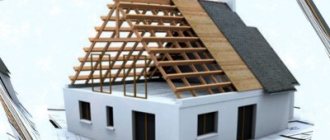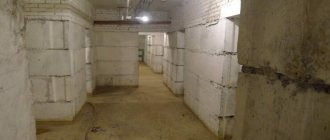Home / Housing disputes / Privatization of the attic above the apartment
Residents of the top floors of an apartment building are looking for opportunities to expand their living space. One option is to privatize the attic above the apartment. An improved attic will not only add square footage in height, but will also increase the value of the living space.
However, you need to remember that the attic is part of the property of an apartment building. According to the law, it belongs to all residents of privatized apartments.
The property of the house is also considered to be elevators, landings, basements, adjacent corridors... Unauthorized seizure of additional space is considered a malicious violation. If a hidden use of the attic is discovered, the offender will be required to return the attic, and in addition to this, to compensate the damage to the other apartment owners.
Is it possible to privatize the attic above the apartment? We propose to understand the issue from the legal perspective. At the same time, you can familiarize yourself with the procedure and nuances of privatization of non-residential premises in a residential building.
Is it possible to privatize the attic above your apartment?
Apartment buildings include property that belongs to all apartment owners. Stairs, attics, elevator shafts - all this is the property of the residents (Article 36 of the Housing Code of the Russian Federation). The latter can enter into an agreement for the maintenance of facilities with the Management Company or Homeowners Association.
Is it allowed to privatize the attic above your apartment? Yes, such a right exists. But in practice, not all residents of the building enjoy the privilege, but only the owners of apartments on the top floors. This is logical, because it is easier for them to arrange additional space and create something like an attic or a two-tier house.
Why do residents need to privatize the attic above their apartment:
- Use for personal purposes - for example, creating an additional room (rest room, warehouse, dressing room).
- Increasing the value of your apartment - housing that is sold together with the attic is much more expensive than ordinary square meters.
- Commercial lease - non-residential objects in the house can be leased to individual entrepreneurs or legal entities; rent becomes an additional source of income.
- Protection from encroachments - the privatized attic above the apartment cannot be used by third parties (for example, the local administration without the consent of the residents).
Thus, privatization of the attic above your apartment is possible - this is a profitable decision to become the owner of non-residential premises. An object can be used for different purposes and benefit from it.
What you need to know
In any multi-storey building there is property that belongs to all owners of apartments and premises of this building. Attics are also classified as such property. That is why many difficulties arise with the privatization of attic space, which ultimately can lead to failure.
Think over all the nuances of this enterprise and only then contact the appropriate authorities to privatize the premises. Privatization of an attic space requires a serious approach to the matter.
It is unlikely that you will be able to do without the help of professionals, so take the advice of experienced lawyers. Even if you have to spend money on their services, you will avoid additional costs in the future, and save your nerves and time.
Attention! Our qualified lawyers will assist you free of charge and around the clock on any issues. Find out more here.
In what cases is it possible?
Only apartment owners can become the owner of an attic space. Most often, located on the top floor of an apartment building, i.e. right under the attic. Residents of municipal apartments do not have this right. Before privatizing the attic, they will have to transfer ownership of the occupied living space.
There are several conditions for privatizing the attic above the apartment:
- the premises are not privatized by anyone;
- the attic does not serve as a crossing point for engineering components (electrical wiring, gas pipelines, water supply);
- the object is not considered emergency (Read “How to privatize emergency housing?”);
- consent of residents of the lower and middle floors.
It happens that the attic space has already been privatized, but the owner does not use it. What to do in such a situation? A smart solution would be to negotiate with the owner to rent the attic. The second option is to try to buy out a non-residential property. Financial costs can be offset by renting out the attic for commercial rent.
Required documents
Mentioned above were two ways to attach an attic to an apartment.
Depending on which of these methods you choose, the package of documents required to achieve your goal will depend.
If you plan to rent an attic or take it for free use, you will need to perform certain actions:
- obtain written consent from the owners of the apartments in your building;
- draw up a rental agreement for the premises and register it with the appropriate authority;
- discuss the issue of attic conversion with other owners and obtain their consent;
- carry out attic conversion;
- receive an act drawn up after making changes to the design of the premises;
- make changes to technical documents;
- reflect all changes in the lease agreement and register them.
What needs to be done to register ownership of the attic space:
- reconstruction work can begin only after obtaining the consent of all apartment owners, that is, first of all, these permits must be obtained;
- to begin the reconstruction of the facility, contact the relevant authorities for permits;
- put the attic into operation. A similar procedure is carried out after repair work and reconstruction of the premises;
- make corrections to the technical characteristics of the attic and register them;
- register ownership of the attic space.
Watch the video. Attaching the attic of an apartment building:
When is privatization impossible?
Before privatizing the attic above your apartment, you need to assess the status of the non-residential premises. There are several factors that prevent the attic from being converted into private property.
Prohibition on privatization of the attic:
- If the premises contain the most important communication nodes, and the privatization of the attic will create access difficulties for management employees and emergency services.
- The apartment building is included in the list of capital repair projects.
- The residential building is subject to demolition.
- The attic space is already owned by another person.
These reasons make it impossible to privatize an attic in an apartment building. However, you can consider the option of renting an attic. The main condition is that it does not create difficulties for access to engineering units, otherwise failure will follow.
Example: The Savelyevs lived on the top floor of a 5-story building.
There is an attic above their apartment. The house was new, so the additional space was in a suitable condition - it resembled an attic. Savelyev was engaged in business - he had a small printing laboratory. Figuring that it would be cheaper to run an individual entrepreneur in the attic close to his apartment, Savelyev posted notices inviting residents to gather for a general building meeting. Further, the individual entrepreneur spoke about the idea and asked permission from the residents to privatize the attic as their property. Of course, not just like that - Savelyev promised the residents a small compensation. Consent was received, the individual entrepreneur went to the housing inspection. Representatives of the management company checked whether the premises met housing standards. It turned out that the attic is the center of communication nodes - cold water pipes, boiler room, electricity. Converting the attic for the needs of a printing laboratory is impossible. Transferring engineering units is also difficult. Savelyev could have privatized the attic, but he was forbidden to place a laboratory there.
Reasons for the ban
Privatization of an attic space in an apartment building is impossible due to non-compliance with the conditions listed above.
In addition, the reasons for a negative decision of a government body on this issue may include:
- non-compliance with legal requirements during the privatization process;
- lack of an established reconstruction project;
- the technical impossibility of reconstructing the attic without a negative impact on the structural characteristics of the residential building.
Reference! The applicant may appeal the decision to deny the right to privatization in court.
How to privatize the attic above your apartment?
Preparation for privatization of the attic above the residential premises has three main directions: obtaining the consent of the residents, registration of the attic and registration of the right in the Rosreestr branch.
Where to go?
Let's start with the question of state inspections, where a person/group of people interested in privatization should apply. The calculation is as follows - you need to find out which units are located in the attic. You will have to contact the authorities that maintain communication systems.
For example:
- Housing Inspectorate;
- Technical department of Rospotrebnadzor;
- Architectural or urban planning department in the region;
- State Fire Supervision of the Ministry of Internal Affairs of Russia;
- Gas technical inspection.
The technical design for the attic conversion is ordered from a licensed company. Specialists will help you complete all the calculations, after which they will prepare a detailed plan for the inspection services. The drafting and approval is carried out by the Architectural Bureau under the local administration . Technical documents can be ordered from the BTI at the place of registration of the house. In addition, the Bureau takes upon itself the responsibility of updating the attic registration certificate.
Order (algorithm of actions)
Let's look at the procedure - it consists of six main stages. Differences may be due to the requirements of regional authorities.
Algorithm:
- Decide on the status of the attic.
- Notify the residents of the building about the privatization of non-residential premises.
- Get the consent of the residents.
- Create a reconstruction plan and obtain permits.
- Order an examination for the reconstruction of the attic area.
- Register ownership in Rosreestr.
The most important stage is the approval of the reconstruction plan for the premises. Some owners convert the attic into a living space - an attic. But for this you need to comply with technical standards and obtain permission from the housing inspection. Read more in the article “How to obtain permission to reconstruct a private house.”
Procedure
Privatizing the attic above your apartment is not considered an extremely complicated procedure. On the contrary, the instructions are quite clear. The main thing is to secure the consent of the residents and not violate the interests of government agencies.
Below we present step-by-step instructions for privatizing an attic:
STEP #1. Residents' meeting
The attic space belongs to the property of an apartment building. No one owns the premises separately, but privatization/renting is impossible without the consent of the residents. Therefore, the interested party needs to organize a general meeting of the residents of the house. The notification is sent out in advance - no later than 10 days before the start of voting.
STEP #2. Collecting votes
Simply attending a meeting is not enough. Residents of the house must vote for the privatization of the attic. Thus, they express their will in writing. It should be noted that not all residents may agree - you will have to show the gift of eloquence and persuasion. If there are people who are dissatisfied or who abstain from voting, privatization will be delayed. Signatures are affixed to a special act, which will subsequently be submitted to the local administration for approval.
Step #3. Permission for reconstruction
Issued by government agencies. The applicant will have to visit the housing department, management company and BTI.
Step #4. Order a project
Manufacturing is carried out by licensed companies. The architectural project includes information about the technical data of the object.
Step #5. Get approval from the authorities
After preparing the project, you can contact the city or district administration. The main issues are resolved by the urban planning department. Specialists will check the project for compliance with architectural standards and make a final decision: approve or reject.
Step #6. Repair and renewal of technical passport
Having received permission, the applicant begins to repair the attic. Immediately after the reconstruction, you will need to submit an application to the BTI and invite specialists to measure the object. If no comments arise, BTI employees will issue an updated technical certificate for the attic space.
Step #7. Registration of ownership
The final stage is an application to Rosreestr. Along with the documents, you must submit an application in the prescribed form. In return, the registrars will issue an extract from the Unified State Register and make changes to the real estate register. You can see the photos and features of the privatization document here.
Documentation
An applicant for attic space must prepare two sets of documents: for a non-residential property and for his apartment.
List of documents for the attic area:
- a copy of the minutes of the general meeting of residents;
- act signed by apartment owners;
- official permission for the reconstruction of the attic;
- a certificate from the BTI on the examination of the premises for suitability;
- certificate from the department of the Ministry of Internal Affairs of the Russian Federation;
- information about the absence of the owner of the premises;
- a copy of the registration certificate for an apartment building;
- explication of the house;
- technical information about the attic area.
Other documents are presented:
- registration certificate of the apartment on the top floor;
- an extract from the Unified State Register of Real Estate – confirms the fact of ownership of the apartment;
- documents of title for housing (sale and purchase agreement, deed of gift, certificate of inheritance, etc.);
- copies + original passport of the applicant.
It is advisable to collect documents in advance. Please note that a certificate from the BTI is not issued immediately - it may take about 30 days to wait for the application. However, there is an urgent paid procedure. The certificate will be issued within a few days.
What documents are needed to privatize an apartment - read our article.
How to decorate an attic in a private house?
In recent years, the practice of equipping attic spaces as attics has spread. This can be a good solution if there is a lack of space, however, due to its unusual shape and non-standard dimensions, the attic can bring a lot of difficulties during redevelopment. Plus, the construction of premises of this kind requires additional permits and registration.
Do I need to register my attic?
According to instruction No. 37 on accounting of the housing stock of the Ministry of the Russian Federation for Land Policy, the attic is considered as a separate floor.
Attic premises are included in the area of a private house and must be registered with the Bureau of Technical Inventory.
To register an attic, you must obtain certificates from the fire service, housing office and sanitary-epidemiological supervision.
The procedure for decorating the attic
Many lawyers strongly recommend starting the design of the attic by preparing the necessary documents for construction work and only then proceeding with the actual construction of the attic space. The result of a negligent attitude to the process of checking and collecting documentation may be a claim from the State Architecture and Construction Service and the demolition of the building.
General procedure for decorating an attic:
- Collection of documents necessary for registration;
- Create a construction project plan. As a rule, this is done by licensed specialists;
- Filling out an application for registration of an attic space;
- Approval of the project in the relevant authorities, one of which is the architectural and construction inspection of the locality;
- Obtaining all necessary documents from the Bureau of Technical Inventory, Housing and Public Utilities and the Sanitary and Epidemiological Station.
Preparation of documents
When initially constructing an attic without permission, the building must be included in the plan. To do this, a specialist from the Bureau of Technical Inventory is called. The employee draws up a special plan and makes all changes to the technical documentation.
Documents required for registration of the attic:
- Homeowner's ID;
- Application on the standard form of the Bureau of Technical Inventory;
- Photocopy of technical passport;
- Extract from the cadastral passport;
- Documents necessary to confirm the fact that the building being considered for the attic is owned by the applicant;
- Technical documents prepared by a specialist from the Bureau of Technical Inventory who came on call and drew up a new plan.
After completing the documents required by the Bureau of Technical Inventory, you will need to contact the registration center. There, changes will be made to the existing records of existing registered properties.
Project development
The popularity of attics in private homes is well deserved. Premises of this kind are economical and convenient.
The main advantage of attics is the ability to rationally use unused space. The construction project should be developed at the planning stage, because the variability in the use of attic meters depends on determining the correct type of roof.
It is possible to achieve comfortable use of an attic space if, even at the project development stage, the area under consideration meets the following conditions :
- Possibility of insulating the room and installing a heating system;
- Availability of a form and layout convenient for living;
- Good illumination of the area;
- Proper planning of the structure, which eliminates the possibility of the building collapsing due to additional load.
The attic project involves the installation of additional supports, columns, windows or walls. Making the area under the roof comfortable for living is not an easy task. The floor for redevelopment can have a wide variety of shapes: symmetrical, broken, triangular, and so on.
There are certain rules for drawing up and developing projects that it is advisable to follow. For example, a narrow small attic is more suitable for a bedroom. It makes more sense to use a high room for a living room. In the areas where the inclined slopes meet the ceiling, it is convenient to place shelving, wardrobes and other pieces of furniture.
Important requirements when planning the attic area that will be used for the bedroom :
- The distance from floor to ceiling must be at least 2.2 meters;
- The distance from the bed level must be at least 1.4 meters.
Compliance with such regulatory requirements is necessary for comfortable use of the premises. Often, due to a frivolous attitude to the layout, tall people are forced to move around the attic, bent over.
Project development requires accurate calculations. For these purposes, experts consider it advisable to use software that is designed specifically for these purposes. This greatly simplifies the process and reduces the risk of serious errors and errors in calculations.
Getting permission
Owners of private houses who decide to build an attic space must obtain special permission. This is a prerequisite for buildings that were originally built much earlier and without an attic.
Since the technical passport and design of a building of this kind does not contain information about the presence of a room under the roof, in the absence of permission, the constructed attic will be considered an unauthorized construction.
This in turn can lead to criminal liability.
Features and the need to obtain permission to build an attic are prescribed in the Town Planning Code of the Russian Federation. If during the construction of a private house the documentation provided for an attic space, then obtaining additional permission for its actual construction is not required.
Without obtaining permission and registering the attic as a residential premises, it is allowed to make changes such as installing new doors and windows in the corresponding openings. Redevelopment, as a result of which the final area of the premises remains the same, is also permitted without obtaining permission.
If it is necessary to increase the total area of the house by installing an attic, you will need to obtain permission from the local administration.
To do this, the owner of the house submits an application to the administration at the place of residence to obtain permission to carry out redevelopment or reconstruction.
The application should indicate the reason why the owner needs reconstruction, and also list the types of work required for this.
In addition to the application, the owner of the building must provide originals and copies of title documents for a private house and a technical passport for the property, which was issued by the Bureau of Technical Inventory. Also, if there are other homeowners, it is required to provide their consent for reconstruction, certified by a notary. In addition, local governments must provide a redevelopment project.
After reviewing the documents submitted by the homeowner, the administration makes a decision on consent or refusal to issue permission to design the attic. As a rule, this takes from one week to a month.
Is it possible to legalize an already built attic?
The legislation of the Russian Federation does not provide for conditions that would prohibit the construction of additional premises above the roof of private houses or the registration of existing ones.
Owners of certain real estate objects, provided that they have officially taken ownership of the inherited possession and indefinite use of the territory under the building in question, can apply to local government authorities to establish ownership of the already built attic.
Often, the housing inspectorate of a local government body or the architecture committee refuses a request to legalize an already built attic. In this case, in accordance with Article No. 222 of the Town Planning Code of the Russian Federation, the owner can register the superstructure as an unauthorized building.
Documents required to legitimize an already built attic or register it as a superstructure:
- Documents that confirm the right of ownership, possession or use of the territory under the building in question;
- Documentation that confirms the fact of independent construction in the space under the roof of the building. These may be survey reports, documents from the Bureau of Technical Inventory and similar certificates;
- Documentary confirmation that during installation no regulatory requirements, construction rules or public safety rules were violated;
- Confirmation that during the construction of the attic space the rights of other persons were not infringed.
It is worth keeping in mind that in the event of a trial, the lack of permission for reconstruction is not a sufficient basis for a decision to refuse recognition of ownership of the attic. However, a person who had the opportunity to obtain permission for an already built attic, but did not take advantage of it, will be denied owner status.
Reasons for refusal of registration
A registered attic allows you to avoid the risk of certain legal difficulties associated with the peculiarities of housing legislation of the Russian Federation. However, there are some situations where formal registration of an attic space is impossible.
Reasons for refusing to design an attic space:
- An individual or legal entity is not the official owner of the land plot under the building being considered for the construction of an attic;
- After the construction of the attic space, a risk arose of a threat to the health and safety of citizens;
- During construction, certain requirements of regulatory and legal acts were discovered that regulate construction work and urban planning;
- During the construction of the attic space, the interests of balance holders or other persons protected by the current legislation of the Russian Federation were not respected or violated;
- During the reconstruction and redevelopment of the building, the historical characteristics of the buildings were violated, which became objects of the cultural and historical heritage of the Russian Federation.
It is worth keeping in mind that government officials take the fight against illegally built, restored or remodeled buildings quite seriously.
The presence of violations and non-compliance with the requirements of the Town Planning Code of the Russian Federation can lead to litigation, serious fines and even the demolition of the attic space. Owners of buildings located near historical and cultural monuments should be especially careful.
Damage to the appearance of certain objects of art due to the construction of extensions and attics against their background is considered a serious reason for opening a criminal case.
Subscribe to our Yandex.Zen channel
If you have questions, consult a lawyer
You can ask your question in the form below, in the online consultant window at the bottom right of the screen, or call the numbers (24 hours a day, 7 days a week):
- 8
— all regions of the Russian Federation.
Source: https://ahrfn.com/pereplanirovka/kak-oformit-mansardu-v-chastnom-dome.html
What is the price?
Privatization of the attic above the apartment is “free” only in words. You will have to pay, and sometimes the sums are considerable. The main costs are related to cadastral documentation. The cost of a technical report from the BTI will cost from 30 to 80 thousand rubles (Moscow and the Moscow region). Electricity supply project - from 40 to 80 thousand rubles, etc. Similarly.
If you resort to the help of specialized companies, the costs will be much higher. At the same time, it is not at all a fact that the applicant will win in the time frame for decorating the attic. The average cost is 150 thousand rubles . However, this does not include attic repairs. Costs are always individual for each case.
Permission to build an attic
Have you decided to replace the attic space in your own home with an attic living space, or do you live on the top floor of a multi-storey building and have a desire to equip the unused space above as an attic? The question arises: is it necessary to have permission to dismantle such a plan and where should I apply?
Permission to build an attic
Permit for a private house
Owners of private houses should be aware that for the construction of an attic space it is necessary to obtain a special permit. This applies to houses built much earlier and without an attic space.
There is no attic space in the project and in the technical passport of such houses, therefore, by completing the work of converting the attic into an attic, you are violating all the documents you have for the house, and the attic will be legally recognized as an unauthorized extension , which in turn will entail the application of the owner of the house to take appropriate measures.
It is clear that if you are building a new house and the project includes an attic room, then you do not need to take out a separate permit for the attic; this is all included in the permit for the construction of a new building.
If the owner has planned to convert the attic space of an old house into an attic, he first needs to study in detail Chapter 6 of the Town Planning Code, namely Article 51 . A construction and reconstruction permit is a document that confirms that your attic project meets all requirements.
It is clear that it is impossible to dismantle the attic space without a project made by specialists.
When drawing up a project for the attic, specialists will study and calculate the pressure exerted on the foundation and walls of the house, whether they can withstand the additional load .
The material for the construction of the attic and roof, the type of rafter system, etc. will also be indicated here, which also affects the load of the walls, ceilings and foundation of the house.
Reconstruction is regulated by the regulations on the procedure for reconstruction of private sector houses and non-residential buildings. You need:
- Submit an application to local authorities (department of architecture and construction). Within a month, the application will be accepted for consideration and you will receive an appropriate decision.
- Provide a development plan for the site, completed by a special company that has permission to do so.
- A detailed description of the work to change the attic space, taking into account all the parameters of the living space.
- Consent of residents living in the house, taking into account those temporarily absent.
- Documents confirming the ownership of the house and the plot on which the house is located.
Only after all this, having permission to dismantle the attic space into the attic, can you begin to develop the project.
Deadlines
The result of privatization of the attic space can be visible within 2-3 months after submitting the application. But as practice shows, registration lasts at least 4-6 months , or even longer. Most of the time is spent on obtaining technical permission, as well as on reconstructing the attic. Until the premises are brought into proper condition, the BTI will not issue updated documents.
So, we see that privatization of the attic above the apartment is a responsible and lengthy procedure. Applicants for an attic will have to hold a meeting, collect signatures from residents, obtain permission, undertake repairs, and only then register ownership of the attic (or rent the attic). At the same time, the nuances of legislation should be taken into account. It happens that the attic cannot be reconstructed due to the so-called “author’s design”, i.e. architectural design.
If you are experiencing difficulties or have little time to study the details of the transaction, contact the lawyers of our portal.
Legal advice will allow you to feel confident and be prepared for various unforeseen situations. Attention!
- Due to frequent changes in legislation, information sometimes becomes outdated faster than we can update it on the website.
- All cases are very individual and depend on many factors. Basic information does not guarantee a solution to your specific problems.
That's why FREE expert consultants work for you around the clock!
- via the form (below), or via online chat
- Call the hotline:
- Moscow and the Region
- St. Petersburg and region
- FREE for a lawyer!
By submitting data you agree to the Consent to PD Processing, PD Processing Policy and User Agreement.
Anonymously
Information about you will not be disclosed
Fast
Fill out the form and a lawyer will contact you within 5 minutes
Tell your friends
Rate ( 1 ratings, average: 5.00 out of 5)
Author of the article
Maxim Privalov
Lawyer. 2 years of experience. I specialize in civil disputes in the field of housing and family law.
Author's rating
Articles written
610
How to legalize an attic in a private house into a living space
Town Planning Code of the Russian Federation, the issuance of a building permit is not required in case of changes to capital construction projects and (or) their parts, if such changes do not affect the structural and other characteristics of their reliability and safety and do not exceed the maximum parameters for permitted construction and reconstruction established by the town planning regulations. Therefore, a construction (redevelopment) permit is not needed in this case. The administration’s refusal in this case is illegal and violates my rights to the reconstructed residential building. In connection with the above, guided by Art. 222 Civil Code of the Russian Federation, art. 51 of the Town Planning Code of the Russian Federation, Art. 29 Housing Code of the Russian Federation, art. 4, 30, 131, 132, 136 Code of Civil Procedure of the Russian Federation, I ASK THE COURT: 1.
Is it necessary to design an attic in a private house?
The fact is that they can give a completely absurd recommendation - contact Rospotrebnadzor for the purpose of approval for compliance with sanitary standards, even if we are talking about premises in a private one- or two-story residential building (despite the norm of paragraph 2 of Art.
49 of the Civil Code of the Russian Federation, according to which an examination for compliance with sanitary and epidemiological requirements is not carried out in this case). However, in this case, you can play it safe and secure the appropriate document by contacting Rospotrebnadzor - after all, you still have to wait. And then there will be fewer reasons for the court to refuse.
However, of course, it would be more professional and easier to clearly explain to the court that there is no need for Rospotrebnadzor’s conclusion in this case.
Attics - life under a roof
Laws that regulate the construction of attics We remind you that unauthorized construction does not guarantee a citizen the right of ownership of the object. That is, you will not be able to sell, donate or even rent out the attic, and in the worst case, you will have to demolish it if you don’t even think about how to legalize it.
This is stated in Article 222 of the Civil Code of the Russian Federation. Unauthorized construction usually refers to a residential building that is built on a site that is not designated for such purposes. There must be a certain procedure for obtaining permits, determining building standards, and the like.
It will be almost impossible to legalize an attic that was built with construction violations and without prior registration.
Statement of claim to the court for the legalization of unauthorized reconstruction
Important As a rule, administration employees themselves suggest what it should look like and can even give a sample. For example, in Ufa this is an urban design center located at:
what kind of girl will accept your documents? Unfortunately, sometimes you have to figure it out on your own. If you want to save time and money, of course.
Attic decoration
I ask the court to preserve the residential building, consisting of letters A, A1, ... with a total area, located on a land plot with a cadastral number, located at the address in a reconstructed (re-planned) condition according to the technical passport of the State Unitary Enterprise BTI of the city of Ufa RB dated. 2.
Recognize as full name ownership of a residential building consisting of letters A, A1, ... with a total area, located on a land plot with a cadastral number, located at the address in a reconstructed (re-planned) state according to the technical passport of the State Unitary Enterprise BTI of the city.
Ufa RB from Date. Attachments (copies of documents in duplicate):
- Statement of claim
- Extracts of ownership of the house.
- Extracts of ownership of land.
- Conclusion of the Federal Budgetary Healthcare Institution “Center for Hygiene and Epidemiology in the Republic of Bashkortostan” dated Date, Number.
How to legalize an attic in accordance with all requirements
Attention Last updated: 01/20/2017 For example, you made an unauthorized reconstruction. However, permission for it (from the administration) was not received. While they were reconstructing, apparently no thought was given to this.
But now it’s time to go to Rosreestr to register ownership of the reconstructed premises. And this is where some difficulty arose. An example of a statement of claim to the court is given below. By the way, in accordance with paragraph 4 of paragraph 17 of Art.
51 of the Civil Code of the Russian Federation, a building permit is not required for reconstruction and redevelopment. Unlike reconstruction. In accordance with paragraph.
28 of the Resolution of the Plenum of the Supreme Court of the Russian Federation and the Plenum of the Supreme Arbitration Court of the Russian Federation dated April 29, 2010 No. 10/22 “On some issues arising in judicial practice when resolving disputes related to the protection of property rights and other property rights”, provisions of Art.
How to legalize an attic in a private house?
The Civil Code of the Russian Federation applies to unauthorized reconstruction of real estate, as a result of which a new object arose, but does not apply in the case of redevelopment, reconstruction (re-equipment) of residential premises. You can read more about the differences between reconstruction and redevelopment or redevelopment here.
The administration will most likely refuse. At least because she is not authorized to authorize what was done without permission - in the case of reconstruction. After all, you can only resolve what has not yet been accomplished, i.e.
only an intention to do something, but not an already existing fact.
The most interesting thing is that the need to go to court may arise even in cases where the reconstruction was carried out INSIDE an existing building. For example, the structural characteristics of the building (load-bearing walls or foundation) were affected.
Consequently, it will be necessary to coordinate the reconstruction with the gas workers (the gas service of your locality). In particular, in the city of Ufa, if they do not object, they write a consent inscription on the technical passport - on the plan of the reconstructed building, certifying it with a seal.
Courts generally accept agreements expressed in this form. So, after you receive a refusal from the administration, a refusal of objections to reconstruction (or consent to it) from third parties, as well as a response from the district administration, all grounds will arise for filing a claim in court.
Because, on the one hand, your right to the reconstructed premises has been violated. On the other hand, you have evidence of attempts to restore the violated right in a pre-trial manner.
But this did not work out for you and for this reason you have no choice but to go to court.
As for generic jurisdiction, when determining it, it should be taken into account that disputes about the demolition of unauthorized buildings, declaring reconstruction illegal and bringing the premises to their original condition, or a ban on construction are property disputes that are not subject to assessment. Civil cases on such disputes, in accordance with the requirements of Articles 23 and 24 of the Code of Civil Procedure of the Russian Federation, fall under the jurisdiction of district courts.
Therefore, when filing a claim, a state fee is paid in the same amount as for a property claim that is not subject to assessment. Those. The state duty will be small. If for some reason you did not meet the limitation period, then in the statement of claim you should write a request to restore the limitation period, indicating the reasons that contributed to its omission.
Otherwise, the court will leave the application without consideration (Article 109 of the Code of Civil Procedure of the Russian Federation). Otherwise, you will have to deal with them in court, after listening to their arguments against the reconstruction you carried out. This, of course, is a topic for a separate discussion.
If the court determines that there is a dispute between you (as the owner of the land plot and building) and them (as land users or co-owners), it will summon them to a court hearing. Keep in mind that we are even talking about easement rights here.
Not to mention the property of the co-owners of your land plot.
For example, a gas pipeline runs through it (no matter where - in the air or underground), close to the reconstructed building, at a distance of 10 cm from the border of the site and there is an encumbrance on the corresponding part of the land (for example, only 0.5 m2), which will be confirmed certificate from Rosreestr for the land plot.
Source: https://juristufa.ru/2018/04/20/kak-uzakonit-mansardu-v-chastnom-dome-v-zhiloe-pomeshhenie/
Design methods
To get an attic space and attach it to a living space, you can use two methods:
- register ownership of the object,
- rent premises or receive them for free use.
Which of these methods to use in your case depends on some nuances: whether a Home Owners Association (HOA) with a specific composition and number of owners was registered in the house, whether there are registered rights to shared ownership, etc.
Procedure for performing the procedure
To legalize the right to an attic space, you will have to go through several stages. First of all, start collecting documentation.
You will need documents on ownership of the apartment, as well as information about the object you want to receive:
- papers indicating your legal status (individual or legal entity),
- property rights or other rights to housing,
- as a result of which you acquired the right to residential premises: as a result of a purchase (purchase and sale agreement), as a result of privatization or equity participation, etc. How much do you plan to use?
- in which building the apartment is located - private or public,
- information about the management company that supervises this house,
- information about the Condominium (whether it was registered in accordance with the norms of current legislation), the passport of the apartment building received from the BTI,
- information about HOA registration.
How to convert non-residential premises into residential ones?
The next stage is related to clarifying the technical characteristics of the attic, namely the part that is associated with the possibility of its reconstruction.
What to do:
- contact the management company and take a duplicate of the Home Ownership Passport, certified in accordance with the law,
- contact the design organization and order a document indicating that the attic space, in all respects, can be converted into living space.
If you were able to obtain permission to refurbish the premises, you can proceed to the third stage.
Important! What to do next:
- prepare a package of documentation that needs to be submitted to the prefecture. This step is necessary in order to select an investor on a competitive basis who is ready to carry out construction work,
- This package includes: design documentation, a conclusion received from the MoszhilNII project, the amount of compensation to the owners of apartments located near the site of construction work. Please note that all project documentation must be approved by certain authorities. A special competition commission is being created at the prefecture, which will determine the composition of the authorities
- the prefect's order will be issued upon completion of the competition. You need to obtain a legally certified duplicate of this document,
- The contract for the reconstruction of the attic space must be registered.
At the final stage, you should perform the following steps:
- prepare a reconstruction project,
- conclude a contract. At the same time, an insurance agreement is signed. This need is dictated by the danger of certain risks arising during construction work,
- draw up an acceptance certificate for the rebuilt facility, receive orders approving acceptance certificates,
- receive documentation confirming the commissioning of the facility, as well as a certificate of assignment of address details,
- obtain the relevant documentation from the BTI and carry out state registration of the right to the attic space, since this room belongs to the newly created property,
- register ownership with the justice authorities authorized to carry out this procedure.
Note! Before you decide to reconstruct the attic space and attach it to your living space as an attic, determine the technical characteristics of your apartment, load-bearing structures, and also determine how strong your house is in order to endure such reconstructions. It is simply necessary to do this, otherwise the most unpleasant consequences may await you.
Subtleties of the matter
A common mistake: residents of the top floor believe that they have an exclusive right to the attic object. Conversion will be considered as self-occupation.
Expert opinion
Egorov Viktor Vasilievich
Lawyer with 10 years of experience. Specializes in family law. Member of the Bar Association.
Specific consequence: lawsuit from residents. The possibility of protection also has a positive side: for example, one of the neighbors secretly rents out the technical floor, which is a violation of the rights of the other owners.
The question of how to privatize the attic above your apartment contains a slight misconception. Privatization in general is the process of transferring state or municipal property into private ownership.
It is obvious that the facilities serving the house are already at the disposal of the residents. In this case, it would be more correct to talk not about privatization, but about obtaining ownership rights.
The key condition that should not be forgotten: the attic should not be someone else’s. If the object has already been assigned, then the whole procedure will be a disaster.
Quite often, even the residents themselves do not know about this. It is also impossible to take possession of premises through which important public communication networks pass.
For example, access to electricity or gas should be shared.
The problem is that important “nodes” of the house pass through the technical floors. There are also restrictions from a purely technical point of view: the degree of roof slope is from 35 to 55 degrees, and the load-bearing capacity of the ceiling should reach 150 kgf/sq.m.
In this case, the minimum total height of the object is 2.3 meters. The complete impossibility of re-equipment is also present in a situation of major repairs: you cannot change the parameters of a house when it is in a state of thorough reconstruction.
There is also the possibility of obtaining not the entire object, but only part of it. The so-called attic area is also subject to “privatization”. The general procedure remains unchanged: an ambitious citizen will one way or another have to go through all the authorities and obtain the consent of his neighbors.
Conversation with residents is a delicate matter. This will require the most “policy” possible.
It is difficult to prove your own good intentions to others. If the person wishing to get the technical floor at his disposal has a good reputation, then the chance of success increases significantly.
Help from the HOA will be a good help, but even here you will need some ingenuity and “connections”.
To attach an attic to an apartment, you will need, figuratively speaking, to go through fire and copper pipes. If there is complete “combat” readiness, then the result will not be long in coming. The main thing here is literacy and a carefully thought-out approach.








